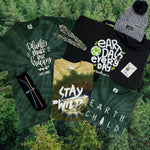About Us
Count to 2, in that time humans just destroyed an entire football field of forest. 80,000 acres are destroyed everyday. 80% of the worlds forests are already destroyed. Lands was created to help spread awareness and save the place we call home! We are called SAVE LANDS because we don't just plant a tree. WE PLANT 12 TREES FOR EVERY ITEM SOLD, taking up an entire piece of land! Every item you are saving a piece of land big enough for 12 trees! With lands you aren't saving just a few trees, together we could save a whole dang forest.
Lands believes in giving back to the earth. We want to fight pollution and make the world a cleaner place for us all. We believe that planting trees is great for fighting air pollution as well as preserving the environment. We hope to spread awareness about land, air, and sea pollution and use our brand to help make a difference.

Our Partnership with Trees.org
We have partnered with trees.org to help us plant 12 trees for every item sold. They are a great organization with a goal and vision that aligns with ours.
So far, with help from our loyal customers we have been able to plant over 1.5 MILLION trees! You can track how many trees have been planted to date by clicking the badge below!
"We can help families escape extreme poverty if they only knew how to transform their lands into Forest Gardens. To build global awareness of our solution we aim to lift a million people out of poverty using the Forest Garden Approach. This initial goal will require working with 125,000 impoverished families to plant 500 million trees."
Not only are trees being planted but jobs are being created to help fight poverty.
You can read more about the good we help do with Trees.org and donate directly by clicking the badge.
1. Who owns the trees?
Farmers own the land and the trees on them. They do the labor and provide the land and water. The trees are their futures. We provide seeds, nursery materials and training, but the farmers own their trees, and are responsible for caring for them.
2. How exactly do trees help people?
There are many ways that trees are beneficial to both people and the environment: Trees are habitat for biodiversity; Trees create much of the planet’s oxygen; and, Trees help combat climate change – the list is nearly limitless, but we focus on the role trees play in agroforestry and in helping farming families improve their land quality and productivity.
Agroforestry integrates trees into agriculture and landscapes, a model that is particularly appropriate for resource poor farmers in developing countries. In addition to providing fruits, berries, and nuts, trees provide environmental services that are essential for families in the developing world: they can improve the fertility of degraded soils (through nitrogen fixation), prevent wind and soil erosion (thereby also contributing to improved fertility), increase water penetration into underground aquifers, and contribute to improvements in the growing environment. Trees help to lessen the wind that might affect crops, cool off ground temperatures, and trap moisture and nutrients in the soil so that food crops grow better in the improved microclimate.
Trees also provide fodder for animals, create living fences, and can be a source of sustainable fuelwood production. (Yes – some of these trees are cut for fuelwood, but these are trees that coppice well – meaning they will grow back year after year when they are properly cared for.)
3. Is a Forest Garden like permaculture?
You may know Forest Gardens by other names, such as polyculture, permaculture, agroforestry, or something else – and these are all related and good descriptions of what we aim for – a multi-layered, multi purpose distribution of vegetables, bushes, and lots of trees – designed to optimize productivity of a piece of land. It is a farming system that thinks vertically, not just horizontally.
Forest gardens stand in stark contrast to modern industrial agriculture which encourages farmers to plant one or few crops. Time and time again, we find monocultures to be chemical-intensive, environmentally-destructive, and deadly to biodiversity and long-term human prosperity.
4. You just plant indigenous trees, right?
No. In the degraded and deforested zones where we operate, we cannot simply plant the types of trees that used to be there. As trees are lost, the growing conditions on a piece of land change. The trees that once stood there cannot regrow in harsh, direct sunlight. We have to find other trees with pioneer qualities that tolerate harsh, full sunlight and arid conditions. After the pioneer species begin to cool the land and improve soil quality we have more success growing a diverse array of fruit trees and hardwoods. There are times when the best pioneer trees for a given landscape and climate are not native, but they are generally naturalized, meaning they already exist and grow in that country.
For us, the primary concern is not indigenous vs. non-native, but rather, of invasiveness. Whether a species is invasive or not is a complex issue; the same species may or may not be considered invasive, depending on local environmental conditions. We work with local forestry specialists and the communities themselves to identify appropriate trees species for each place we operate.
Further, many of the most economically beneficial species can be both non-native and non-invasive. For example, we plant many orange, mango, and banana trees every year at some of our project sites in Africa, even though they are not indigenous.
5. What do you do for water?
Water is a critical limiting factor in our line of work, so we have come up with many ways to mitigate the challenges faced. For example, when we select communities, we prioritize those that either do not have a history of water shortages in their well or just recently gained access to running water.
When we train people in arid lands to establish nurseries, we have found ways for farmers to grow seedlings by using minimal amounts of water, even gray water which is left over from other household tasks.
When designing Forest Gardens, we often have to select drought-resistant trees which survive on little water, and we plant windbreaks to minimize the drying effect – evapotranspiration as it is called – that dry winds have on the land.
We time our nurseries so that seedlings are planted at the beginning of every rainy season, maximizing the amount of time they get rained on as most trees we plant are not watered throughout the dry season.
6. How do you know the trees are planted?
We have developed a world-class monitoring and evaluation process that meticulously tracks the number of trees planted, where, and by whom. This data is digitally collected and processed for our team to locate problems and success in each Forest Garden, so that they can be attended to.
Part of this process includes interviewing each individual farmer at least twice a year to determine how their Forest Garden is producing, any issues that need to be mitigated, and if they are having success at the market.
7. What are some types of trees you plant?
Farmers in TREES programs grow a variety fast-growing trees, thorny trees, fruit trees and hardwoods to create their Forest Garden.
They plant thorny trees, such as Acacia species, in living fences to protect their fields. The plant fast-growing, multipurpose trees to produce fertilizer, animal fodder and fuelwood. Our most popular fast-growing trees include: Acacia, Sesbania, Calliandra, Albizia, Leucaena and Cassia species. They plant fruit trees for food to eat and sell. Mangoes, citrus, cashew, avocado, and jujube are particularly common. For longer term investment, farmers often want to plant hardwoods such as mahogany, gmelina, and grevillea.
Here is a more comprehensive list of species we have planted across Africa:
Multi-Purpose Fast-Growing Trees
Acacia angustissima (Acacia, Prairie Acacia, White Ball Acacia)
Acacia mellifera (Acacia, Blackthorn, Senegalia mellifera)
Acacia nilotica (Acacia, Vachellia nilotica, Gum Arabic Tree)
Acacia polyacantha (Acacia, White Thorn)
Acacia senegal (Acacia, Senegalia senegal, Gum Acacia, Gum Arabic)
Albizia chinensis (Albizia, Chinese Albizia)
Albizia lebbeck (Albizia, Siris, Lebbeck, Woman’s Tongue Tree)
Albizia schimperiana (Albizia, Forest Long-Pod Albizia)
Azadirachta indica (Neem)
Calliandra calothyrsus (Calliandra)
Cassia siamea (Senna siamea)
Delonix regia (Flamboyant, Flame Tree, Royal Poinciana)
Faidherbia albida (Acacia albida, Apple-Ring Acacia, Winter Thorn)
Gliricidia sepium (Gliricidia, Cacao de Nance, Madre de Cacao)
Jacaranda mimosifolia (Jacaranda, Fern Tree)
Leucaena diversifolia (Leucaena, Red Leucaena, Wild Tamarind, Leucaena Petit Feuille)
Leucaena leucocephala (Leucaena, White Leadtree)
Leucaena pallida (Leucaena; synonyms are: dugesiana, esculenta, oaxacana, and panilulata)
Morus sp. (Mulberry)
Parkinsonia aculeata (Parkinsonia, Jerusalem Thorn)
Senna siamea (Senna, Cassia Tree, Cassia siamea)
Senna spectabilis (Senna, Cassia fastigiata, Cassia excelsa, and various Cassia species)
Sesbania sesban (Sesbania, Egyptian Rattle Pod)
Sesbania grandiflora (Hummingbird Tree)
Sesbania macrantha (Sesbania, Mlindaziwa)
Fruit and Nut Trees
Adansonia digitata (Baobab, Monkey-Bread Tree, Upside-Down Tree)
Anacardium occidentale (Cashew)
Balanites aegyptiaca (Desert Date)
Citrus sp. (Citrus, Orange, Lemon, Lime, Tangerine, Grapefruit, Pomelo, etc.)
Cocos nucifera (Coconut)
Cola acuminata (Cola, Red Cola, Kola Nut)
Dacryodes edulis (African plum, Bush Plum, Safou, Prune)
Elaeis guineensis (Oil Palm)
Garcinia kola (Bitter Kola)
Irvingia sp. (Bush Mango)
Macadamia integrifolia (Macadamia Nut)
Mangifera indica (Mango)
Monodora myristica (Groundnut Spice, Calabash Nutmeg)
Moringa oleifera (Moringa, Drumstick Tree, Horseradish Tree)
Persea americana (Avocado, Pear)
Phoenix dactylifera (Date Palm)
Psidium guajava (Guava)
Ricinodendron heudelotii (Njangsa, Njasang)
Tamarindus indica (Tamarind)
Ziziphus mauritiana (Jujube, Goa)
Timber Trees
Acrocarpus fraxinifolius (Pink Cedar)
Cedrela odorata (Spanish Cedar)
Cordia africana (Codria, Cordia abyssinia)
Gmelina arborea (Gmelina, Beechwood, White Teak)
Grevillea robusta (Grevillea, Silky Oak)
Khaya anthotheca (East African Mahogany)
Khaya senegalensis (Mahogany, Bois Rouge)
Maesopsis eminii (Umbrella Tree)
Milicia excelsa (African Teak)
Podocarpus sp. (Podocarpus)
Prunus africana (African Cherry, Prunus, Pygeum, Red Stinkwood)
Tectona grandis (Teak)
Vitex keniensis (Vitex, Meru Oak)
Shrubs, Vines and Fruiting Plants
Agave sisalana (Sisal)
Cajanus cajan (Pigeon Pea)
Carica papaya (Papaya)
Coffea sp. (Coffee)
Dovyalis caffra (Kai Apple)
Jatropha curcas (Jatropha, Physic Nut)
Musa spp. (Banana and Plantain)
Passiflora edulis (Passion Fruit)
Punica granatum (Pomegranate)
Solanum betaceum (Tamarillo, Tree Tomato)
Tephrosia vogelii (Fish Bean)
Theobroma cacao (Cocoa)
Garden and Field Crops
Allium sp. (onion, leek, garlic)
Beta vulgaris (Beet)
Brassica sp. (Cabbage and other brassica species such as Collards, Kale, etc.)
Capsicum and Piper sp. (Pepper; all types; hot and sweet)
Citrullis lanatus (Watermelon)
Colocasia and Xanthosoma sp. (African yams)
Cucurbita sp. (Includes pumpkin, butternut squash, etc.)
Daucus carota (Carrot)
Lactuca sativa (Lettuce)
Manihot esculenta (Cassava)
Phaseoulus vulgaris (Beans; various types)
Solanum lycopersicum (Tomato)
Solanum melongena (Eggplant)
Solanum tuberosum (Irish Potatoes)
Spinacia oleracea (Spinach)
Zea maize (Maize)






















